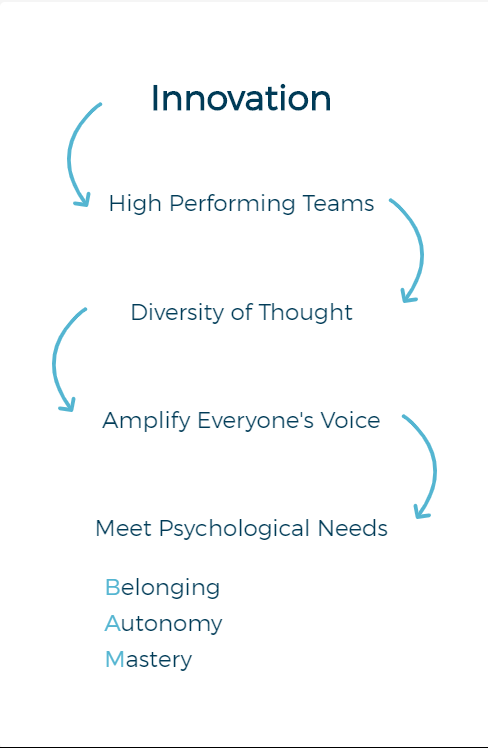
Amplify Everyone’s Voice: Tactics to Build Team Belonging
Christa McAuliffe would’ve been the first teacher in space. Instead, the space shuttle carrying her, the Challenger, broke apart 73 seconds after leaving Earth. Christa and the team never made it.
It looked like a technical problem; the shuttle wasn’t sealed for liftoff. But the root cause was human: managers at NASA knew about this flaw for nine years. Engineers tried to speak up, but they were ignored. NASA wasn’t a safe place to voice concerns. The culture didn’t tolerate or learn from failures. This hurt NASA’s performance, sacrificing seven lives in the process.
The Challenger disaster is an example of groupthink. When no one speaks up against a bad choice, dangerous things can happen. NASA wasn’t amplifying everyone’s voice or prioritizing safety. If engineers could speak up safely and leaders took their concerns seriously, they could have avoided this disaster.
How can we build teams to amplify everyone’s voice?
Cultivate BAM behaviours
We all have three basic psychological needs: belonging, autonomy, and mastery (what we call BAM needs). When team members’ BAM needs are met, everyone’s voice gets amplified.
- When you have belonging, you can speak up to your team and they will listen.
- When you have autonomy, you have the freedom to choose what’s best.
- When you have mastery, you thrive as a skilled contributor.
By meeting members’ BAM needs, innovation increases; teams are motivated and can perform well. In teams like these, members speak up to avoid groupthink and disasters like the Challenger tragedy.
We all need to belong
We feel belonging when we are welcomed by our chosen groups. At work, we need to belong to our team; they can make our workplaces fun and inspiring or miserable and demotivating. We can belong to our organization or our Employee Resource Group, but our motivation, performance, and retention are in danger if we feel excluded by those around us in our daily work.
Why? When our team excludes us, it hurts. The phrase “sticks and stones can break my bones, but words can never hurt me” isn’t true. Our brain processes social exclusion like physical pain. When our community excludes us, we feel depressed and hopeless. Exclusion, by a person or in a computer game, makes us feel less belonging, self-esteem, and meaning in the world. Everyone loses when we exclude.
Belonging has business benefits
Building team belonging is a critical step towards innovation and business performance.
Can team belonging avoid disasters like the Challenger space shuttle crash? Yes!
- Nurses who feel they belong provide better patient care and stay longer.
- People who want to belong, but don’t, do more harm to their coworkers.
- Airline crew members who belong are more likely to speak up.
People who belong at work are more motivated and committed. They perform better, help more, and are easier to retain. By focusing on belonging, we open a treasure trove of behavioural science evidence to build behaviour, culture, and performance.
So, how do you achieve it?
It’s not always easy. It requires courage, vulnerability and curiosity. We worry about being excluded, fixating on ourselves and how we feel. Yet if we focus outward, on others, we can send belonging signals and hear everyone’s voice. If we focus outside, we start a chain reaction of belongingness that pays us back generously.
Small actions make a big difference

Think Small: Design for Team Belonging
In a presentation, the speaker asked six hundred people and I to turn to our groups. He said, “When one of you brings up an idea, respond with ‘no, but…’. Take turns.” 600 of us participated, but there wasn’t much discussion. Saying “no, but…” shut us down; we didn’t talk much.
Then he said, “now respond with ‘yes, and…’ instead.” The room lit up like it had twice as many people. You could hear the energy when people sent a simple belonging signal and lifted each other up.
Small behaviours that signal “you belong” have a big impact. It seems counterintuitive, but belonging comes in each small moment, not in one grand gesture. Our team experiences build belonging; each meeting, email, and expression can bring teammates together or push them away. These moments are subtle. But once we’re looking for the small moments that matter, we see a million opportunities for belonging cues.
Is our team connected? Do we share a future? Do all team members feel safe? These three questions underpin belonging behaviours. Here’s some small actions for your next team meeting:
1. Let Others Speak First
Often, team meetings are for getting the answer ASAP. To get there, we might jump in before the team shared all the information. Other people might see our first guess as the final answer—especially if we’re in a senior role—and hold back important information and diverse views. We didn’t intend to but sharing out loud can shut down the conversation early or create competition, not cooperation. Here’s a habit to try: Ask “what do you think?” to the team before giving your opinion. Simple? Yes. Powerful? Absolutely.
2. Overcommunicate Your Listening
A great listener is harder to come by than we might think. Silence can be uncomfortable. If we can teach people to listen well, we’ll get collaboration and team belonging. Hone your listening habits by practicing these behaviours:
- Ask expansive questions: Stay curious using phrases like “Tell me more” and “Why?”—without interrupting.
- Build on others’ ideas: Try saying “Yes, and…” (instead of “No, but…”).
- Physically connect: Gestures such as nodding, leaning in, and making eye contact when listening sends signals that you value the other person.
3. Get Close and Connect
Virtual teams are all the rage, but visual contact and physical proximity is surprisingly important to communication, belonging, and performance. Where team members work makes a difference. Another floor can feel like a different country, so try moving desks together. For virtual team members, overcommunicate using video, sharing jokes, and pulling up a chair with the distant person’s photo as a reminder of who’s on the phone.
4. Say “Thank You!”
Simply saying “thank you” can ignite cooperation that spreads. When people helped a student (Eric) write a letter, Eric thanked half of them, and the other half got a neutral message. Steve, a different student, then asked them for help. Those who got a thank you from Eric helped Steve 2x more often as people who weren’t thanked. A small thank you can spark generosity to others. A thank you is more than expressing gratitude, it’s a contagious belonging cue.
5. Give Inclusive Feedback
Feedback can be scary. We hate ambiguity; when someone says, “Can I give you some feedback?”, we might brace for impact. We can change this.
Feeling anxious about feedback doesn’t prepare us for it. Fortunately, we can use one sentence to transform feedback and ensure everyone feels heard:
“I’m giving you these comments because we have very high expectations, and I know you can reach them.”
Inclusive feedback works because:
- The person feels connected: Using “we” brings you into the group to build belonging
- There’s a shared future: Sharing high standards sets a challenging goal to work toward, together
- It feels safe: Hearing their confidence in you can help feedback feel constructive
Small changes. Big difference.
We can drive team belonging by practicing small habits every day. One or two belonging signals is not enough—we need many signals to meet our BAM needs. Luckily, small actions soon become habits. Making small changes to our meetings, communication, and feedback builds a culture that says, “it’s safe to speak up here”.




Comments